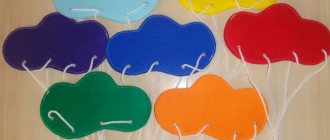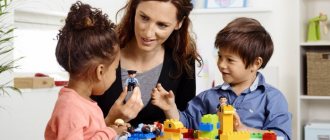Useful Guides
It seems to me that the essence of the problem lies in the fact that integrated lessons in preschool educational institutions began to be held not so long ago. Of course, this is no longer know-how, but this definition entered pedagogy only in the 90s of the twentieth century. In addition, the concept of a complex integrated lesson is often used in the literature. And how can you figure out what the differences are, and even draw up a clear GCD plan?
I think that it will be much easier to study the features of each activity using specific examples. For my part, I can recommend some interesting manuals for teachers, which, it seems to me, give a clear idea of the structure, goals and objectives of both classes.
Complex lessons are conveniently distributed by topic with the expectation that the teacher will be able to conduct them every week, in the book by N. S. Golitsyna “Notes of complex thematic lessons” for the senior group. It seems to me that in the future these notes can be taken as a model when preparing for independent studies and on other topics, since they are well compiled.
By the way, there are similar benefits for preschoolers of different ages. For example, the orientation of this book is already a preparatory group. Notes for the entire academic year are collected here.
As for integrated classes, for conducting them with children of the same age there is a book by the author A. V. Adzhi, which contains notes on such classes for the preparatory group of a kindergarten. In it I found a description of about a hundred activities aimed at the speech development of six- to seven-year-old children and the activation of their cognitive activity.
Of course, I have not provided a complete list of useful benefits here, but have only shared my own experience. I would be glad if you also share useful books on our topic. Tell us, what literature do you use, dear colleagues?
Integrated Learning Models
In addition to the forms, there are such modern models of organizing integrated inclusive education as:
- continuous full integration;
- constant but incomplete integration;
- partial integration;
- time integration;
- episodic integration;
- combined integration.
Continuous full integration
With this model of integrated education, children with inclusion attend a general education school together with other students and receive additional correctional assistance if necessary. Permanent full integration is possible in two cases:
- the child’s level of development is close to normal, without significant deviations;
- In addition to the teacher, the school also has a separate specialist.
Constant but incomplete integration
This model is suitable for children who have deviations from the age norm. They require specialized assistance and cannot attend all classes at the same time as other students. Teachers and parents determine which subjects the child will take with the class, and what is easier to master with the help of a specialist.
Partial integration
In this model, greater importance is given to the individual education of a child with special needs. And he attends classes at a comprehensive school only partially or spends time with children after his main studies.

The earlier developmental features are identified, the greater the chances for successful adaptation.
Temporal integration
In this model of integrated learning, an inclusion child spends time with regular children at school at least twice a month. And he studies individually according to a specially developed program.
Episodic integration
This model is used in schools where it is not possible to organize full-fledged integrated training: there is no separate specialist, there is no opportunity to modernize teaching. In this case, periodic events are organized that help socialize children with special needs.
Combined Integration
A learning model that is used in small localities if they do not have opportunities for any kind of integrated education. In this case, only some elements of inclusive education are used. Therefore, the combined model is suitable for children with minimal developmental disabilities, otherwise they simply will not be able to master the educational program on an equal basis with other students.
Common features of integrated and complex lessons
Agree, it is difficult to understand how a complex lesson differs from an integrated one, also because in the literature one concept is often replaced by another. Have you also probably encountered this problem? There is also a combined lesson. How do you understand what makes it special?
For me, the situation became a little clearer when, armed with the above-mentioned literature and drawing on personal experience, I identified some similarities between integrated and comprehensive lessons:
- The content of both classes is concentrated around one topic, in contrast to the combined one, where, as I understand it, different types of activities simply replace each other.
- Such thematic classes require interdisciplinary connections.
- Both of them are multidirectional, not substantive.
- During them, a logically justified and plot-related change of various types of activity in children (cognitive, physical, speech, musical, artistic) necessarily occurs.
Features of integrated classes
Despite their common features, comprehensive and integrated lessons demonstrate a different approach to learning. Correct me if I'm wrong! What is special about each activity? I'll tell you how I understand this for myself. Perhaps you see the situation differently, I will be glad to see your comments, since the topic is really very complex!
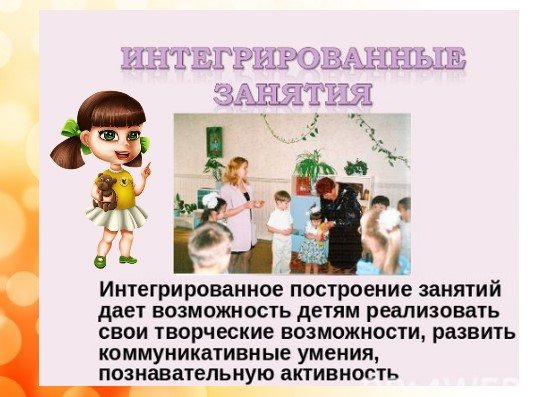
I think that specific examples will make my explanation more clear, so let’s assume that we are considering the topic “Spring” in the senior group of a preschool educational institution:
- By integrating blocks from various disciplines, we will create in children holistic knowledge on our topic, that is, form their idea of spring as a seasonal phenomenon.
- During this lesson, students will definitely gain new knowledge! But at the same time, it is also important that they already have some certain “baggage” of ideas about spring. Otherwise, we simply won’t have anything to base the conversation on, right?
- Planning a lesson involves constructing the material in a certain way, with the construction of a clear and thoughtful scheme. I usually use mind maps. In this case, in the center we will have a key concept (“spring”), and other concepts (seasons, flowers, wintering and migratory birds, the main signs of spring, etc.) will already be logically connected with it. How does preparing notes go for you, tell us?
What is integrated learning
Integration is a technical term that refers to any process of combining parts into a whole. But in the pedagogical system it has its own specifics: it is used in matters of inclusion, that is, the inclusion of people with various types of disabilities in public life.
So, in education, integrated learning is an educational model in which a child with special needs is not taught separately, but together with other children.
Integrated or inclusive education is not only an opportunity for people with developmental disabilities to feel part of society, but also a way to develop tolerance, empathy and caring for others from the first years of life.
Salamanca Declaration
In 1994, the World Conference on Special Needs Education was held in Spain. Within its framework, the Salamanca Declaration was adopted, which formed the basis of the concept of integrated education. Here are its main provisions:
- every child has the right to basic education;
- Each child is unique and has his own interests and different levels of abilities;
- these features should be taken into account in the learning process, creating comprehensive educational programs;
- General education schools must create conditions for comfortable learning for all children, including inclusion.
Thus, basic models of integrated learning began to emerge, which allowed children with special needs to gain access to a full-fledged school education.
The university also uses integrated or integrated learning technologies. But there this term is understood as methods that involve an integrated approach to vocational education. This is achieved through the development of interdisciplinary connections, the use of project work, Agile and Scrum methodologies and other tools.
What is important to remember?
Here is another important property: the types of children’s activities in such a lesson cannot be strictly divided, they will smoothly flow into one another. We can organize the cognitive activity of pupils in such a way that they will remember the different seasons of the year, analyze seasonal changes, learn to distinguish and group spring flowers, migratory and wintering birds.
Then you can unobtrusively move on to a speech game, which takes the form of reading poetry about spring. Physical activity is, for example, the outdoor game “Spring Flowers”, and artistic activity is drawing or appliqué “Snowdrop”.
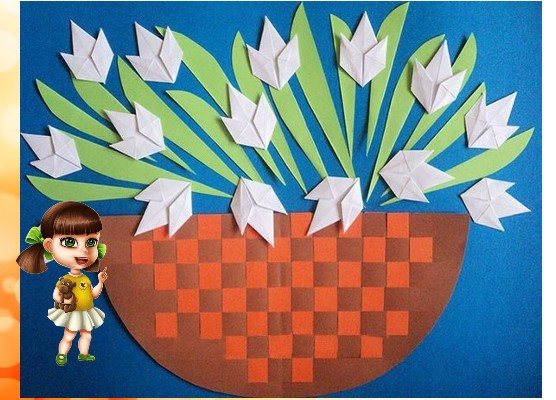
I think such classes can be conducted in the middle group of preschool educational institutions, only the form of presenting the material, of course, will be simpler. If, for example, you have a 2nd junior group, then the lesson dedicated to spring will most likely be complex, since for kids all the lessons are basically the same.
Well, these are just my examples. How do you conduct integrated classes in kindergarten? Maybe you can still highlight some features that I did not take into account, share your experience!
I almost forgot, I can also recommend you one good manual by N. N. Leonova, “The Artistic and Aesthetic Development of Children 5-7 Years Old.” It contains notes from classes that involve teaching children visual arts in non-standard ways. Very interesting, in my opinion!
Speech is a means of communication that serves as the most important tool for the socialization of children. The development of speech is associated with the formation of both the personality as a whole and the basic mental processes. Good speech is the most important condition for the comprehensive development of children. The richer and more correct a child’s speech, the easier it is for him to express his thoughts, the wider his opportunities for understanding the surrounding reality, the more meaningful and fulfilling his relationships with peers and adults, the more successful his education at school.
Speech arises along with the emergence of consciousness - the highest form of reflection of reality. In unity with speech, thinking also arises, characterized precisely by the fact that it reflects reality in concepts, that is, in generalizations that are formalized and consolidated in the word. Knowing the word denoting a concept helps a person to operate with this concept, that is, to think. Speech and thinking are not identical processes; they form a complex unity with each other. Thus, the development of speech (expansion of vocabulary, mastery of grammatical forms of language, development of coherent speech) creates the prerequisites for the development of thinking. And, conversely, clear thinking (the ability to correctly perceive reality) helps to correctly and consistently form a coherent statement. If a child is not able to express his thought in a language form that is clear and understandable to other people, then there are flaws in the thought itself and a lack of understanding of what is happening. At the same time, adults should concentrate on the accuracy, clarity and completeness of the child’s speech formulations, that is, on the material shell of thinking - speech. Then both of these processes will receive additional development.
The criterion for the quality of speech of a child of any age group is the ability to correctly, fully and accurately express one’s thoughts, logically and coherently construct a statement and make it understandable and accessible to the interlocutor. Therefore, one cannot help but attach importance to how thoughts are expressed in words. This especially needs to be kept in mind when training and education. The correctness and comprehensiveness of statements are important not only for the development of children’s speech, but also for the development of thinking, instilling in them the ability to logically formulate and develop their thoughts, thus forming reasoning (logical) thinking.
Logical thinking is thinking based on reasoning and evidence. Judgments are interconnected, that is, a time sequence and cause-and-effect dependencies are established between them. It is very important that children learn to observe temporal sequence in the presentation of their thoughts, knowledge and are able to justify their judgments causally. After all, one of the most important requirements of the culture of speech is that each subsequent statement follows from the previous one, is connected with it, and each new sentence expands the thought, develops what was said or introduces new facts and judgments.
To develop children's thinking, it is important that they learn to make inferences. Inference is a way of indirect knowledge of reality. Thus, from the judgment “A black cloud is approaching” the thought is extracted: “Now it will rain.” Cause and effect can always be found in an inference. In our example, “A cloud is approaching” is the cause, “It will rain” is the effect. It is not difficult to detect a time sequence here.
The most favorable period for the development of children's intellectual and creative abilities is the period from 3 to 9 years. It is during this period that maximum effort must be made to develop speech, perception, memory, attention and thinking.
The modern child finds himself in an information flow. And not everyone can navigate it. “Processing” all the information often turns out to be a very difficult task. To solve this problem and successfully prepare children for school by mastering computer technologies, it is not so much certain knowledge that is required, but the ability to think consistently and logically, guess, and mentally strain. Logic is the science of the laws and forms of such thinking, which is distinguished by strict certainty, consistency and validity. It obeys the laws of identity, contradiction, and the excluded middle. The laws of logic often act as rules of logical thinking. To develop logic, training is required. For preschoolers, this is one of the most important components of their mental processes. Mastery of logical techniques determines the ease and speed of establishing cause-and-effect relationships and develops speech activity.
Some techniques for teaching logical thinking are well known to teachers; they closely resemble developmental exercises and assignments. Play, development of thinking, vocabulary work, creativity, cognition, self-development - these are the fundamental components that are involved in the sphere of attention of the teacher when he turns to the problem of the logical development of a preschooler in classes on speech development.
Play is a necessary condition for the formation of personality, its consciousness and self-awareness: it is the most important factor in mental and speech development. Play communication is the necessary basis within which the formation and improvement of a child’s speech activity takes place. Game classes are conducted in accordance with the schedule of classes by age; the accumulated material and games can be used in special moments. Classes are conducted in subgroups and have their own structure, developed during work with children. At each stage of the lesson, specific tasks are set.
Logical thinking is closely related to the development of mental processes, such as perception, memory, thinking, therefore in the classroom much attention is paid to the development of these processes. The children are offered games: puzzles; Crosswords; “Find out by description”; “What’s extra?”; "Animal Family"; “The master’s work is afraid”; “Whose house?”; “The peacock has a peacock’s tail”; “Who will be who”; “Place it in order”; “Comparison of objects from the same classification group”; “It happens, it doesn’t happen”; "Nonsense"; “Repeat the group of words, but in the plural”, “Word within a word”; “Let's restore the fairy tale”; "Cheerful words"; “Words are associations”; “Say the opposite”; "Steps"; "Good bad"; “What are they talking about?” “Guess the sound, choose the word”; “What is the difference between words”; "Who is bigger"; "Poetry porridge"; "Unravel the proverb." In the preparatory group, children can independently solve logic problems, solve puzzles, and crosswords.
Logic games, like educational games, have the following characteristic features:
1. The need to act in an imaginary way, which leads to the development of all types of thinking, the ability to build imaginary situations;
2. The ability to fantasize, which makes the child independent of various circumstances, allows you to modulate responses;
3. Logic games contribute to the development of imagination, intellect, memory, and improve personality.
Children learn to maintain consistency in the transmission of events, conduct a dialogue, their vocabulary expands, concentration, observation, and perseverance develop. They learn to guess, plan, compose, tell stories, ask the right questions, and find interesting and unusual solutions. The classes use visual, practical and verbal teaching methods. Classes are built on a communicative and cognitive basis, which provides children with creative independence. The development of speech, verbal and logical thinking, memory and imagination makes it possible to cultivate an independently thinking, creative personality. The content of the lesson system is based on the principles of pedagogical optimism, humanism and is aimed at instilling in children a respectful attitude towards themselves and others, and a tolerant attitude towards the opinions of their interlocutor. Such activities not only help children master the means of communication, but also convince them that there is a close connection between thoughts, feelings and behavior in the process of communication. These game activities help each participant to be heard and understood by peers, teachers and parents. In preschool age, play is the leading activity, and communication becomes a part and condition of it. At this age, that relatively stable inner world is acquired, which gives grounds for the first time to call the child a personality, although, of course, a personality that is not yet fully formed, but capable of further development and improvement. This is facilitated by gaming activities. Thanks to the game, the child’s personality acquires a very important new formation: the motivational-need sphere develops in the game; cognitive and emotional egocentrism is overcome; arbitrariness of behavior develops; mental actions develop.
The work uses visual material, both factory-printed board games and cards made with your own hands together with your parents.
How to activate a child’s speech and thinking activity? To activate thinking, it is necessary to carry out the following types of work:
- Develop categorical perception, mental operations (correlating features with objects and phenomena, correlating objects and phenomena according to the degree of expression of a feature, classification, comparison, analysis of relationships between objects and phenomena - analogies);
- To develop the ability to identify essential features of objects and phenomena and give definitions to concepts (identifying the main idea, composing riddles, descriptive stories according to plan, forming logical definitions of concepts, correcting fables, etc.);
- Encourage a transition from using ready-made connections between objects to their independent discovery (establishing logical, including cause-and-effect relationships, searching for new connections between objects and phenomena, etc.);
- Stimulate the desire to explain what is happening and reason (finding the causes of events described in stories, determining the sequence of events, refuting false judgments, etc.)
- Formation of the ability to ask questions (arbitrarily posing a question, moving from establishing-type questions to questions - hypotheses, carrying out a targeted search for the unknown using a question, etc.);
- To develop the ability to understand the hidden meaning of objects and phenomena, the ability to see from different points of view, to practice mental experimentation (determining the figurative meaning of phraseological units, finding solutions in hypothetical situations, understanding the ambiguity of words);
- Develop the planning and regulating functions of speech (action according to verbal instructions, composing stories based on individual words, questions, models, pictures, exercise in verbal formulation of an algorithm of actions).
To activate the dictionary, you can use the following types of work:
- guessing objects by description;
- comparative description of two objects: by contrast, by similarity;
- selection of synonyms and antonyms for certain words;
- matching the names of parts to the name of the whole concept and vice versa (car: body, cabin, headlights; bottom, spout, lid - kettle). Conducted based on constructive activities;
- selection of particular concepts to a general concept and vice versa (names: Petya, Olya, Misha; rose, dandelion, cornflower - flowers);
- interpretation of polysemantic words (the bottom of a cup, pan, river, sea; glass is beating, heart, student over a task, bird; cold weather, hand, water, snowflake);
- explanation of the meaning of set expressions, proverbs and sayings;
- retelling the story.
To activate children’s verbal communication, it is necessary to take into account a number of tasks, the implementation of which will be a decisive condition for successful work:
- develop imitative activity in play and everyday situations;
- conduct didactic and outdoor games;
- act out scenes with situational communication, conduct role-playing games (doctor - patient, teacher - student, seller - buyer);
- activate speech in various activities that are significant for the child;
- expand the emotional experience of children, teach them to understand certain emotional states and express them with facial expressions, gestures, and speech;
- saturate the child’s experience with sensory impressions using auditory, visual, tactile stimulation: show an object, possible actions with it, touch the object, name the object, using the name word in different sentences (Big house, there is a bench near the house, people came out of the house, towards the house a car pulled up);
- create problematic situations, analyze them together with the child, develop his ability to reason, explain, prove, and draw conclusions.
To achieve success in work, you need to make it interesting, emotional, visual; carry it out systematically and systematically; celebrate the child’s achievements (ignorance is not punished, the desire for knowledge is stimulated). In addition, as practice shows, speech must be taught by example. When a child hears correct speech, in which comparisons, antonyms, synonyms are used, enriched with images, clear, he involuntarily perceives it and little by little the good habit acquires the powerful force of habit. From a simple, understandable song, a fairy tale told on a cozy sofa, a child’s mind blossoms, greedily absorbing impressions of goodness and beauty. Preschool teachers lay in children a model of correct speech, constantly taking care of expanding children's vocabulary, developing children's ideas, forming general concepts, and leading them to master the grammatical system at any time during any lesson.
Activation of speech and thinking activity of preschool children is closely related to the problem of activation of cognitive activity. To successfully activate children’s speech and thinking activity, the following conditions must be met:
- creating a favorable psychological climate during OOD;
- organization of various forms of work: individual, pair, group;
- correctional work taking into account the child’s individual educational route;
- work on flexible curricula and programs, widespread use of individually selected teaching aids;
- creating conditions for a differentiated approach to students. Clear knowledge of specific goals, subject to their feasibility, the ability to fulfill the teacher’s requirements, activate the cognitive abilities of children;
- creating conditions for the manifestation of independence.
Currently, preschool education is intensively developing in different directions: interest in the personality of a preschool child and his uniqueness is increasing; qualitatively new requirements are imposed on the organization of the educational process aimed at the physical, social-personal, cognitive-speech and artistic-aesthetic development of the preschooler. The fundamental principle for the development of modern preschool education, proposed by the Federal State Educational Standard for the structure of an exemplary general education program for preschool education, is the integration of educational areas.
In preschool education, it is no coincidence that special attention is paid to the integration of educational areas, since a preschooler holistically perceives the world around him, and for him there should be no boundaries between educational areas.
Preschool age is a sensitive period for the formation of children's ideas about the world around them. Therefore, the task of a kindergarten is not to quickly teach a child to read and count, but to show him the diversity of this world, teach him to see patterns and dependencies in it, and support them with arguments and facts from various fields of knowledge available to the pupil; awaken cognitive interest. In order for the learning process to be positive for the child, special attention must be paid to the content of education.
One of the requirements of preschool didactics is that the content of children's education should be small in volume, but capacious. This requirement will be met if, when forming the content of the cognitive development of preschoolers, we cover numerous aspects of a particular phenomenon, enriching and developing the totality of the child’s personal experience. Fragmentary information from different fields of science does not become knowledge for a child, since it is not updated in his life, and, accordingly, a holistic idea of the world as a single system where everything is interconnected is not formed. An integrated approach to choosing the content of education helps solve this problem at the present stage. One of the main forms of implementing an integrative approach in a preschool institution is integrated classes. Taking into account the age characteristics of preschoolers, the integration of educational areas makes it possible to show the child the world in all its diversity with the involvement of scientific knowledge, literature, music, painting, theater, which contributes to the emotional development of the child’s personality and the formation of his creative thinking.
Integrated lesson - combines knowledge from different educational fields on an equal basis, complementing each other (considering such a concept as “mood” through works of music, literature, painting). At the same time, during the lesson the teacher has the opportunity to solve several development problems.
Integrated classes combine various areas of knowledge, the content of which is selected by the teacher based on a specific topic dictated by the program in which the kindergarten operates. During such classes, children master the content of various sections of the program in parallel. This allows children to see a holistic picture of the world, to develop systematic knowledge and generalized skills.
In a preschool institution, various areas of child development can be integrated:
- familiarization with the outside world and speech development;
- familiarization with the outside world and reading fiction;
- formation of natural science concepts and reading fiction;
- formation of ecological culture and reading fiction;
- formation of ecological culture and musical development;
- visual arts and reading fiction;
- visual arts, reading fiction and musical development;
- formation of elementary mathematical concepts and constructive activities;
- the formation of elementary mathematical concepts and artistic work;
- formation of elementary mathematical concepts and familiarization with Russian culture;
- familiarization with Russian culture and musical development;
- familiarization with Russian culture and visual arts;
- formation of valeological knowledge and physical development;
- development of the emotional sphere and musical development.
Integrated classes encourage preschoolers to actively explore the surrounding reality, find and understand cause-and-effect relationships, develop logic, thinking, communication abilities and speech.
The form of integrated classes is non-standard and interesting. The use of various types of work during the lesson maintains the students’ attention at a high level, which allows us to talk about the sufficient effectiveness of the lessons. Integrated classes relieve fatigue and overstrain of pupils by switching to a variety of activities, significantly increase cognitive interest and motivation for learning, develop imagination, attention, and memory. An integrated lesson also involves the mandatory development of students’ creative activity. Integrated classes have the greatest effect when they are conducted within the system.
One of the important principles of designing an integrated lesson is determining the relationship between familiar and new material. An integrative approach to the pedagogical process allows preschoolers to form a holistic picture of the world during the learning process and create the prerequisites for their comprehensive development.
The essence of a comprehensive lesson
Well, we’ve dealt with integrated lessons, now let’s move on to complex ones. They are usually built on material already familiar to students. A certain general theme is also taken as a basis, and the diverse activities of students are built around it. For example, the theme of spring could be dedicated to the lesson “The Adventures of the Merry Snowdrop”, “In the Spring Meadow”, etc. You can come up with any name!
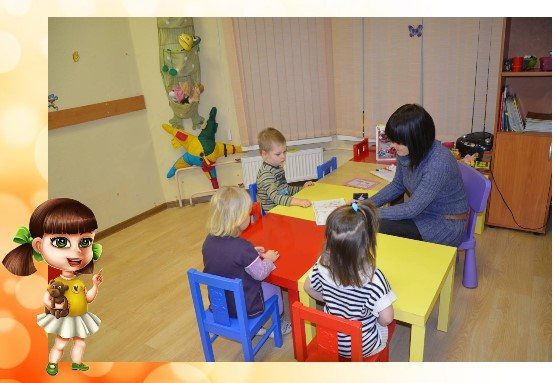
Of course, it is assumed that the children already know that the snowdrop is a spring flower, so this will be more likely a middle than a junior group. This is what is important: during this lesson, the children do not expand their knowledge about the properties of this flower and do not learn about why it appears earlier than the others. Snowdrop is only the main character.
Here is how the activities of students united by a common theme can be organized:
- Students’ speech development can take place in the form of an entertaining conversation, during which the teacher will also demonstrate paintings by artists and children’s drawings depicting the arrival of spring. This same stage also includes cognitive activity.
- Next, together with Snowdrop on a cheerful train, the children can go to a spring clearing in the forest (the outdoor game “Chuk-Chuk” for physical development).
- On the way, when they meet a stream, they will sing a funny song with it (musical development).
- In the clearing they will collect and count snowdrops (mathematical development).
- At the end of their journey they will make a spring appliqué (art development).
The change in actions during such an activity is usually very clearly visible. This is explained by the fact that they are aimed at developing certain skills, and not at the formation of holistic ideas about spring, as a seasonal change, in our case.
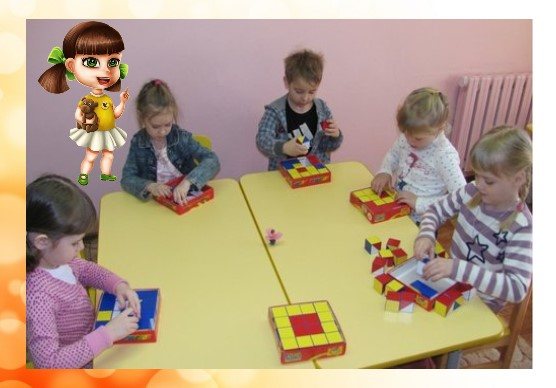
Again, this is just my example, perhaps you can tell us about some of your interesting activities? Leave your comments, I will be glad to learn from my colleagues!
Integrated learning technology
The concept of integrated learning includes not only a tolerant attitude, but also the use of modern technologies in education. After all, the transition to this type of progressive education requires modernizing the entire school system. Namely:
- attract the necessary specialists who will assist teachers during teaching;
- use innovative pedagogical solutions and ideas;
- adapt the curriculum to take into account the characteristics of all children in an integrated class;
- place emphasis on the development of creative and cognitive abilities;
- actively involve parents in the educational process.
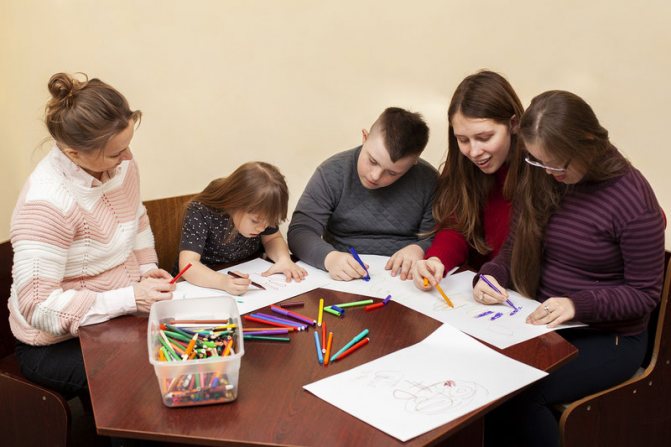
When working with special children, the teacher needs the help of a specialized specialist
Final recommendation
By the way, there is also such a good manual edited by N. E. Veraksa with lessons for children of the older group: “Comprehensive lessons according to the program “From birth to school”.” The book is quite voluminous, but this is good, because in it you can find useful notes for the whole academic year!
Well, I hope I was able to answer your question more or less clearly, dear readers! If there are some points I have not yet covered in my article, then please write about it in the comments! Share your valuable comments on our topic!
I wish you success in conducting a comprehensive or final integrated lesson at your preschool educational institution. Recommend the article to colleagues and friends, and be sure to subscribe to updates, because a lot of useful and interesting things await you ahead.
Sincerely, Tatyana Sukhikh! Till tomorrow!
By the way, I recommend reading:
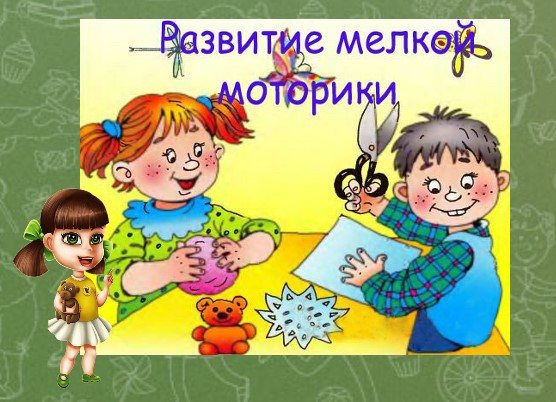
Forms of integrated learning
According to the organization of the educational process, four forms of integrated learning are distinguished:
- attending a regular secondary school class;
- attending a special class in a secondary school;
- studying in a correctional school with subsequent transfer to a general education school;
- full or partial inclusion in the educational process during vocational training.
By the way! Our readers now have a 10% discount on any type of work.

